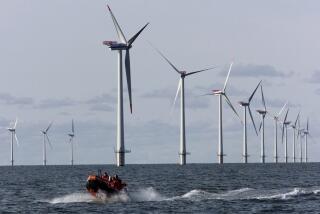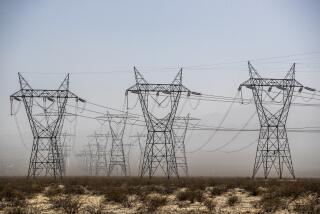Cash-Strapped Farms Embrace Winds of Change
- Share via
WALLULA JUNCTION, Wash. — Like many ranchers facing pressure from developers, Shirley Hindman worries that one day she might have to break up her Nine Mile Ranch, one of the largest spreads in the Walla Walla Valley.
“That would make me sick,” she says.
But now she and her father, Billy, have found another way to protect their 14,000 acres of sagebrush-covered hills and canyonland. The answer has come in the wind--something “we have plenty of,” she says.
And something also in growing demand.
Soon the ridgelines across U.S. 12 from Hindman’s corrals will be dotted by windmills. By next year Hindman and several other property owners, including a nearby college, expect to be landlords to the world’s largest wind farm.
Along southeastern Washington and into neighboring Oregon, 450 Danish-built windmills--sleek white towers 200 feet high with rotors 200 feet across--will churn out enough power for 75,000 families served by Pacificorp, one of the Northwest’s leading electric utilities.
Nearly 100 of the wind turbines already are producing. Gravel roads and concrete slabs for the others are in place. “It will help us keep Nine Mile. It will help us sustain a way of life,” says Hugh Preston, Hindman’s husband.
More than just an economic hedge for farmers and ranchers, wind farms across the West and upper Midwest are emerging as a growing part of the nation’s electricity picture. Major projects are operating or earmarked for completion within a year in Kansas, Minnesota, Montana, Nevada and Texas.
While windmills still account for only a fraction of 1% of the electricity produced in the United States, they no longer are the exotic playthings of a few dreamers. Increasingly, big-time players are showing interest in wind to supplement fossil fuel-powered electricity plants, nuclear reactors and hydroelectric dams.
“Wind is a technology that’s now reliable and proven,” says Robert Morrison, vice president for renewable business development at FPL Energy, the Florida-based company building the 300-megawatt Oregon-Washington project. The cost of generating electricity from wind has declined from 38 cents a kilowatt-hour 20 years ago, to 3 to 5 cents a kilowatt hour in today’s larger projects, says the industry. That’s competitive with natural gas.
“Suddenly this stuff is economical,” says Morrison, whose company has other wind projects under way or being planned in a half-dozen states including Texas, Kansas and Wisconsin.
Other emerging players include Enron, the giant Houston-based energy conglomerate, and the government’s Bonneville Power Administration, which this year sought $1 billion worth of wind energy projects and received more bids than expected.
“The response blew us away,” said George Darr, Bonneville’s manager for renewable resources. Some of the projects will begin operating late next year.
Windmills now account for only about 2,500 megawatts of generating capacity nationwide, but the production is expected almost to double by the end of 2001 to provide enough electricity for 1.3 million households. The industry anticipates that in two decades wind power will grow to 100,000 megawatts and account for 6% of the country’s electricity.
In comparison, nuclear power currently provides about 20% of U.S. electricity, coal-fired plants 52%.
Wind’s sudden popularity has astounded even its biggest boosters.
“We are in a boom year,” says Randall Swisher, executive director of the American Wind Energy Assn., the industry’s trade group in Washington, D.C. “We are expecting huge growth, especially in the West.”
That is good news for David Bittersdorf, president of NRG Systems Inc., a Vermont company that makes wind-measuring devices. “We’ve grown 40% this year,” he says. His company, which had $10 million in sales, expects business to quadruple over the next five years.
For the Hindman family at Nine Mile Ranch, turbines rising from the scrub mean cash in the bank, while not interfering with their 700 head of cattle. Typically, farmers and ranchers involved in such lease arrangements get about $2,000 a year per turbine.
“Wind is a very lucrative crop for farmers,” says Bill Clemens, president of the Chamber of Commerce in nearby Walla Walla. The windmills are “a real curiosity” and may even add to the valley’s tourist trade, he said.
Ironically, the region does not provide the most ideal location for wind power.
What some call the Saudi Arabia of wind stretches from eastern Montana and the Dakotas, through Kansas, Nebraska and into Texas--a region with enough wind potential to power the nation, according to the Energy Department.
James Dehlsen, an early wind energy pioneer, dreams of putting together a massive wind complex of 2,000 turbines stretching over 90 miles of prairie in South Dakota. It would be 10 times as large as the Washington-Oregon project and produce a staggering 3,000 megawatts of electricity.
“We’re at the early stages of the project,” said Dehlsen, founder of the Zond Corp., a U.S. wind turbine manufacturer that has since been bought by Enron. But he said he already has a commitments from 150 farmers for use of 176,000 acres.
More to Read
Inside the business of entertainment
The Wide Shot brings you news, analysis and insights on everything from streaming wars to production — and what it all means for the future.
You may occasionally receive promotional content from the Los Angeles Times.










